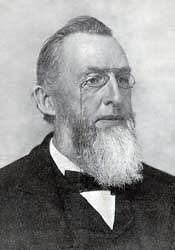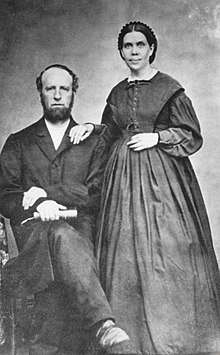Uriah Smith
Uriah Smith (May 3, 1832 – March 6, 1903) was a Seventh-day Adventist author, minister, educator, and theologian who is best known as the longest serving editor of the Review and Herald (now the Adventist Review) for over 50 years.
Uriah Smith | |
|---|---|
 | |
| Personal details | |
| Born | May 3, 1832 Wilton, New Hampshire |
| Died | March 6, 1903 (aged 70) |
| Occupation | Author, Inventor and Editor of Review and Herald of the Seventh-day Adventist Church |
| Part of a series on |
| Seventh-day Adventist Church |
|---|
 |
|
|
|
Organization Divisions
|
|
| Adventism |
Uriah Smith was an extremely versatile and creative individual. Some of his lesser known contributions include his work as a poet, hymn writer, inventor, and engraver. He patented an artificial leg with a moveable ankle[1] and a school desk with an improved folding seat[2] and several other inventions and improvements. At the time of the formation of the General Conference of Seventh-day Adventists in 1863, Smith was elected as the first secretary. He later held this same position again five separate times. He also served a term (1876–77) as General Conference treasurer.
Ordained to the gospel ministry in 1874, in that same year he also helped co-found Battle Creek College. As a theologian in residence at church headquarters he regularly taught Bible classes, ministerial workshops, and chaired the college board.
As the author of numerous books, Smith carved some of the first woodcut illustrations published by early Sabbatarian Adventists. He was one of the most prolific authors of early Adventism. His best-known work is Thoughts on Daniel and the Revelation often abbreviated simply as Daniel and the Revelation.[3] It became the classic text on Adventist end-time beliefs.
He died in Battle Creek, Michigan, in 1903, at the age of 70, from a stroke on his way to the Review office. [4]
His older sister Annie R. Smith was an early Seventh-day Adventist poet and hymnist.
Early life
Uriah Smith was born in 1832 in West Wilton, New Hampshire. His family accepted the Millerite message and in 1844 experienced what has become known as the Great Disappointment. That same year, Smith had his left leg amputated due to an infection. Following the Disappointment, Smith lost interest in religion and commenced schooling at Phillips Exeter Academy in Exeter, New Hampshire. In December 1852, he accepted the message taught by Sabbatarian Adventists which in 1863 became the Seventh-day Adventist Church. In 1853, he began working at the offices of the Advent Review and Sabbath Herald (now the Adventist Review), becoming its editor in 1855. His main contribution to Adventist theology was a commentary on the prophetic Biblical books of Daniel and the Revelation, but he also wrote extensively on conditional immortality and other topics. He advocated religious liberty, the abolition of slavery, and noncombatancy for Adventists.
Publications
- The Warning Voice of Time and Prophecy (1853)
- The Bible Student's Assistant, Or, A Compend Of Scripture References (1858)
- Mortal or Immortal? Which?, or, An Inquiry into the Present Constitution and Future Condition of Man (1860)
- The Two Covenants (1860s)
- Which? Mortal, Or Immortal? : Or, An Inquiry Into The Present Constitution And Future Condition Of Man (1864)
- Daniel and the Revelation
- Thoughts on Daniel, Critical and Practical, on the Book of Daniel 2nd edn (DjVu format)
- An Appeal to the Youth: Funeral Address of Henry N. White (1868)
- The Visions of Mrs. E. G. White : a Manifestation of Spiritual Gifts According to the Scriptures (1868)
- Poems with Rebekah Smith and Annie R. Smith (1871)
- The United States in the Light of Prophecy, or, An Exposition of Rev. 13:11-17 (1872)
- The State of the Dead and the Destiny of the Wicked (1873)
- The Sanctuary And The Twenty-Three Hundred Days Of Daniel VIII, 14 (1877)
- The Biblical Institute with James White (1878)
- A Sketch of the Last Sickness and Death of Elder James White with W. C. Gage and John Harvey Kellogg (1881)
- Man's Nature And Destiny, or, The State Of The Dead, The Reward Of The Righteous, And The End Of The Wicked (1884)
- Our Country's Future. The United States in the Light Of Prophecy, or, an Exposition of Rev. 13:11-17 (1884)
- Synopsis of the Present Truth : A Brief Exposition of the Views of S. D. Adventists (1884)
- An Exposure of Fanaticism and Wickedness with George Ide Butler(1885)
- The Marvel of Nations. Our Country: Its Past, Present, and Future, and What the Scriptures Say of It (1886)
- Modern Spiritualism: a Subject of Prophecy and a Sign of the Times (1896)
- Here and Hereafter, or, Man in Life and Death (1897)
- Looking Unto Jesus, or, Christ in Type and Antitype (1897)
- Our Country, the Marvel of Nations (1901)
See also
- Seventh-day Adventist Church
- Seventh-day Adventist theology
- Seventh-day Adventist eschatology
- 28 fundamental beliefs
- Questions on Doctrine
- History of the Seventh-day Adventist Church
- Millerites
- William Miller (preacher)
- Adventist
- Ellen G. White
- Teachings of Ellen White
- List of Ellen White writings
- Prophecy in the Seventh-day Adventist Church
- Second coming
- Premillennialism
- Remnant (Bible)
- Investigative judgment
- Three Angels' Messages
References
External links
| Wikimedia Commons has media related to Uriah Smith. |
- Adventist Heritage - URIAH SMITH - Biographical Sketch
- Ellen G. White Estate(R): Pathways to the Pioneers - Uriah Smith
- Works by Uriah Smith at Project Gutenberg
- Works by or about Uriah Smith at Internet Archive
- Articles by Smith and about Smith as cataloged in the Seventh-day Adventist Periodical Index (SDAPI)
| Preceded by James White |
Editor of the Adventist Review 1855–1861 |
Succeeded by James White |
| Preceded by James White |
Editor of the Adventist Review 1864–1869 |
Succeeded by J. N. Andrews |
| Preceded by J. N. Andrews |
Editor of the Adventist Review 1870–1871 |
Succeeded by James White |
| Preceded by James White |
Editor of the Adventist Review 1872–1873 |
Succeeded by James White |
| Preceded by James White |
Editor of the Adventist Review 1877–1880 |
Succeeded by James White |
| Preceded by James White |
Editor of the Adventist Review 1881–1897 |
Succeeded by A. T. Jones |
| Preceded by A. T. Jones |
Editor of the Adventist Review 1901–1903 |
Succeeded by W. W. Prescott |